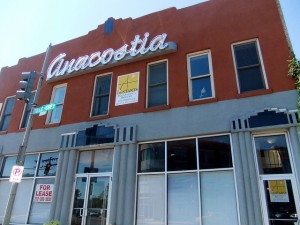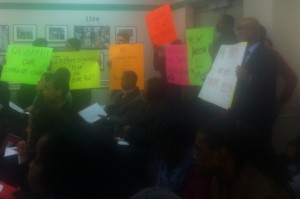Protesting Social Service Groups in the Name of Economic Development

tedeytan / Flickr
Anacostia's commercial corridor is filled with vacancies.
A vocal group of Anacostia residents have been rallying against a nonprofit’s plans to open transitory housing along the neighborhood’s business corridor. Calvary Women’s Services hopes to open along Good Hope Road, SE by summer, and provide semi-permanent housing for 50 formerly homeless women.
On the one hand, the objections can be viewed as typical NIMBYism. There’s also fear that placing transitory housing on an underutilized commercial corridor will cripple future economic development — while many of D.C.’s neighborhoods have undergone a transformation in which vacant buildings are converted into coffee shops and sit-down restaurants, Anacostia has lagged behind.
But the opposition in Anacostia is complex, which many residents say has become a dumping ground for social services because of the community’s demographics.
“There’s this perception about Anacostia that it’s all a bunch of poor black people who are out here struggling, and that they’d be happy to have [more social services] here,” said Nikki Peele, Congress Heights on the Rise blogger.
Peele, along with a standing room crowd, packed a Ward 8 community meeting Thursday night where they slammed Calvary representatives for not having met with residents before its move was practically a done deal. “Disrespect” was mentioned throughout the meeting. Some, such as Phil Pannel, suggested the nonprofit didn’t feel the need to approach residents because they “knew perfectly well that this is a dis-empowered community.”
When asked why Calvary chose Anacostia, Calvary board president Tracy Ballard said “it was the right place at the right time.” The deal was a good one; the nonprofit bought the vacant Anacostia building for $950,000 in December 2010, with a $3 million plan to convert it into 14,000 square-feet of living space for 50 women, and serve 100 meals a day. The purchase was a matter of right, meaning Calvary didn’t have to go through any rezoning processes that would give residents a chance to prevent it.

Elahe Izadi / DCentric
Residents during a Ward 8 meeting hold signs protesting transitory housing for homeless women.
Calvary representatives tried to reassure residents; the building would be secure and loiters would be moved along. They also tried convincing the assembled crowd that they won’t be a business-killer, using as evidence all of the development that happened in their current neighborhood.
“We’ve been in Gallery Place-Chinatown since our founding in 1983,” Thompson said. “[Now], there’s a Starbucks across the street, a Busboys and Poets, all of that was built up around us.”
But the reality east of the Anacostia River is a different one than in Chinatown. Some development in the works is intended to spur more growth. That includes the ongoing $300 million 11th Street Bridge project, which will provide an easier connection between Anacostia and west of the river.
“[The bridge] was supposed to bring us back into the rest of the District of Columbia,” ANC8A Commissioner Greta Fuller said. “What do we have at the foot of the bridge? A transitional housing building.”
The irony is that by relocating to Anacostia, the group could very well better serve Ward 8 residents in need of such assistance — about 36 percent of Ward 8 residents live below the poverty line, according to census estimates. And that’s not lost on opponents of the project.
“I’m not personally against transitory housing for women who need help, but in its proper place,” said Edith Cromwell, an Anacostia Economic Development Corp. board member. “We’ve been promised this becoming a business, commercial district for a long time… This is economic suicide.”
-
Monipo1
-
http://profiles.google.com/annwatt Ann-Marie Watt
-
http://profiles.google.com/annwatt Ann-Marie Watt





